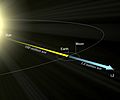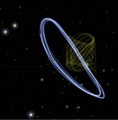Lagrange point facts for kids
Lagrange points are special spots in space where the gravity of two large objects, like a planet and a star, balances out. This balance creates stable places where a smaller object, such as a satellite or an asteroid, can stay in orbit without using much fuel. Think of it like a sweet spot where everything lines up perfectly!
These points are found in the orbits of the Earth and the Sun, or the Moon and the Earth. Many Trojan asteroids are natural objects that hang out in these special spots.
Contents
What Are Lagrange Points?
Lagrange points are five specific locations where a small object can orbit. At these points, the pull of gravity from the two big bodies and the forces from their motion all cancel each other out. This means a small object can stay in a fairly stable position. We find dust clouds, asteroids, and even human-made satellites at these points.
The idea for these points comes from a smart mathematician named Joseph-Louis Lagrange. He wrote about them in 1772, long before we even dreamed of putting satellites into space!
The Five Lagrange Points
There are five Lagrange points, named L1, L2, L3, L4, and L5. They each have different levels of stability.
L1, L2, and L3: The Unstable Ones
The first three points (L1, L2, and L3) are called metastable. This means they are a bit like balancing a pencil on its tip. If a satellite at one of these points moves even a little bit out of place, it will drift away. It would need to use its own fuel to get back into position.
- L1 is located between the two large bodies. For example, between the Sun and Earth.
- L2 is located beyond the smaller of the two large bodies. For example, beyond Earth from the Sun.
- L3 is located on the opposite side of the larger body. For example, on the other side of the Sun from Earth.
L4 and L5: The Stable Ones
L4 and L5 are considered truly stable. These points are like valleys where objects tend to collect. If a satellite or asteroid at L4 or L5 gets a little off course, the forces of gravity and motion will gently pull it back into place. It will then just wobble around the Lagrange point.
- L4 is located 60 degrees ahead of the smaller body in its orbit.
- L5 is located 60 degrees behind the smaller body in its orbit.
Satellites and Asteroids at Lagrange Points
NASA has sent satellites to two of the Sun-Earth Lagrange points.
- The L1 point (between the Earth and the Sun) is perfect for satellites that need to watch the Sun. These satellites look for things like solar flares, which can affect Earth. The ACE satellite orbits around the Sun-Earth L1 point.
- The L2 point (beyond the Earth, away from the Sun) is a great spot for space telescopes. This is where the famous James Webb Space Telescope is located. It's about 1 million miles (1.6 million kilometers) away from Earth! The WMAP spacecraft also orbited the Sun-Earth L2 point.
Because L4 and L5 are so stable, they have collected natural objects over time. For the Earth-Sun system, we've found dust clouds and at least one asteroid at these points. Bigger planets, like Jupiter, have many more asteroids in their L4 and L5 points. These asteroids are known as Trojan asteroids.
Images for kids
-
Gaia (yellow) and James Webb Space Telescope (blue) orbits around Sun–Earth L2
See also
 In Spanish: Puntos de Lagrange para niños
In Spanish: Puntos de Lagrange para niños






